Comprehensive Report: Business Process Management and Reengineering
VerifiedAdded on 2023/01/13
|13
|1925
|90
Report
AI Summary
This report provides a comprehensive overview of Business Process Management (BPM) and Business Process Reengineering (BPR). It begins with an introduction to BPM, exploring its benefits such as customer focus and employee satisfaction, and its shortcomings, including complexity. The report contrasts BPM with BPR, highlighting their lifecycles and the potential of combining both. It then delves into the foundations of BPMN, including questions and answers related to connecting BPMN pools, and the use of different connection elements. The intermediate BPMN section explains BPMN models, reviews model specifications, and presents scenarios and calculations related to competitive offers. The report also includes a detailed bibliography of relevant sources, making it a valuable resource for understanding and applying BPM and BPR principles. The report includes diagrams and analysis to further illustrate the concepts discussed.
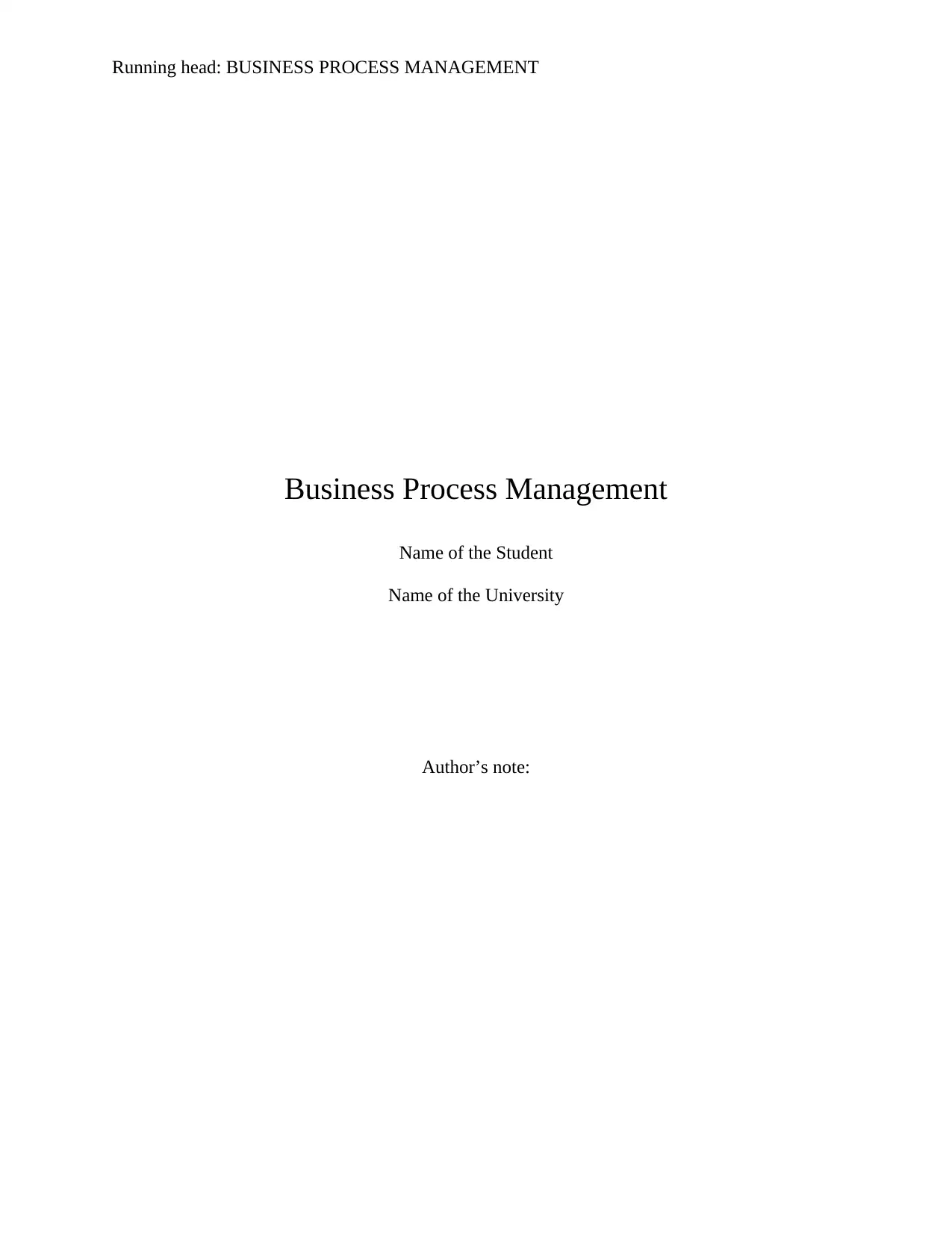
Running head: BUSINESS PROCESS MANAGEMENT
Business Process Management
Name of the Student
Name of the University
Author’s note:
Business Process Management
Name of the Student
Name of the University
Author’s note:
Paraphrase This Document
Need a fresh take? Get an instant paraphrase of this document with our AI Paraphraser
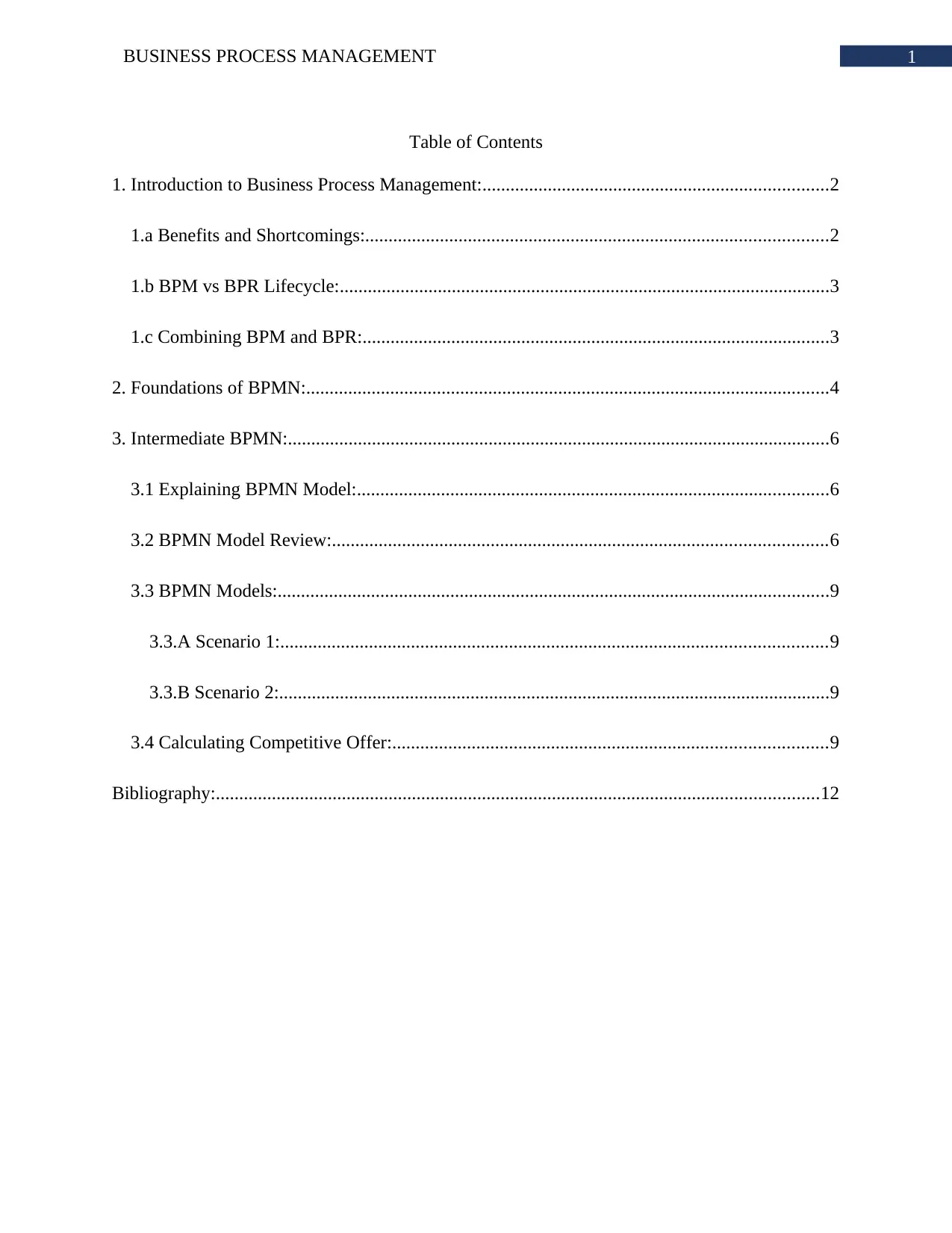
1BUSINESS PROCESS MANAGEMENT
Table of Contents
1. Introduction to Business Process Management:..........................................................................2
1.a Benefits and Shortcomings:...................................................................................................2
1.b BPM vs BPR Lifecycle:.........................................................................................................3
1.c Combining BPM and BPR:....................................................................................................3
2. Foundations of BPMN:................................................................................................................4
3. Intermediate BPMN:....................................................................................................................6
3.1 Explaining BPMN Model:.....................................................................................................6
3.2 BPMN Model Review:..........................................................................................................6
3.3 BPMN Models:......................................................................................................................9
3.3.A Scenario 1:.....................................................................................................................9
3.3.B Scenario 2:......................................................................................................................9
3.4 Calculating Competitive Offer:.............................................................................................9
Bibliography:.................................................................................................................................12
Table of Contents
1. Introduction to Business Process Management:..........................................................................2
1.a Benefits and Shortcomings:...................................................................................................2
1.b BPM vs BPR Lifecycle:.........................................................................................................3
1.c Combining BPM and BPR:....................................................................................................3
2. Foundations of BPMN:................................................................................................................4
3. Intermediate BPMN:....................................................................................................................6
3.1 Explaining BPMN Model:.....................................................................................................6
3.2 BPMN Model Review:..........................................................................................................6
3.3 BPMN Models:......................................................................................................................9
3.3.A Scenario 1:.....................................................................................................................9
3.3.B Scenario 2:......................................................................................................................9
3.4 Calculating Competitive Offer:.............................................................................................9
Bibliography:.................................................................................................................................12

2BUSINESS PROCESS MANAGEMENT
1. Introduction to Business Process Management:
1.a Benefits and Shortcomings:
Business Process Management:
Advantages:
Business process management has many different advantages. Customer focus is one of
the main aspects of BPM (Rosemann & Vom Brocke, 2015). It helps in focusing on the customer
and helps in faster delivery and customizations. Employee satisfaction is another benefit of BPM
as it increases productivity by automatizing repeating tasks. This creates a happy environment in
workplace. BPM is also known for its consistency, transferability and repeatability. Each task in
BPM is executed with accurate planning and design. BPM can be easily adapted and improved
with changing times and deliver expected outcomes. This feature increases the sustainability of
the process. All the processes in BPM can be measured from start to end and the results then can
be compared with the help of analytical tools. This helps estimate the performances of each
employee.
Disadvantages:
Business Process Reengineering also has many disadvantages too. The complexity of the
BPM is a very important disadvantage (Jeston 2014). While it can be used to complete a variety
of tasks and make the business process smooth. The process can become very complex and
challenging. Skilled employee will be needed for proper operation of the BPM. The main feature
of BPM is to automate repetitive tasks and implement processes to improve and optimize them.
This can also lead to slashing of employees or job cuts in organizations.
1. Introduction to Business Process Management:
1.a Benefits and Shortcomings:
Business Process Management:
Advantages:
Business process management has many different advantages. Customer focus is one of
the main aspects of BPM (Rosemann & Vom Brocke, 2015). It helps in focusing on the customer
and helps in faster delivery and customizations. Employee satisfaction is another benefit of BPM
as it increases productivity by automatizing repeating tasks. This creates a happy environment in
workplace. BPM is also known for its consistency, transferability and repeatability. Each task in
BPM is executed with accurate planning and design. BPM can be easily adapted and improved
with changing times and deliver expected outcomes. This feature increases the sustainability of
the process. All the processes in BPM can be measured from start to end and the results then can
be compared with the help of analytical tools. This helps estimate the performances of each
employee.
Disadvantages:
Business Process Reengineering also has many disadvantages too. The complexity of the
BPM is a very important disadvantage (Jeston 2014). While it can be used to complete a variety
of tasks and make the business process smooth. The process can become very complex and
challenging. Skilled employee will be needed for proper operation of the BPM. The main feature
of BPM is to automate repetitive tasks and implement processes to improve and optimize them.
This can also lead to slashing of employees or job cuts in organizations.
⊘ This is a preview!⊘
Do you want full access?
Subscribe today to unlock all pages.

Trusted by 1+ million students worldwide
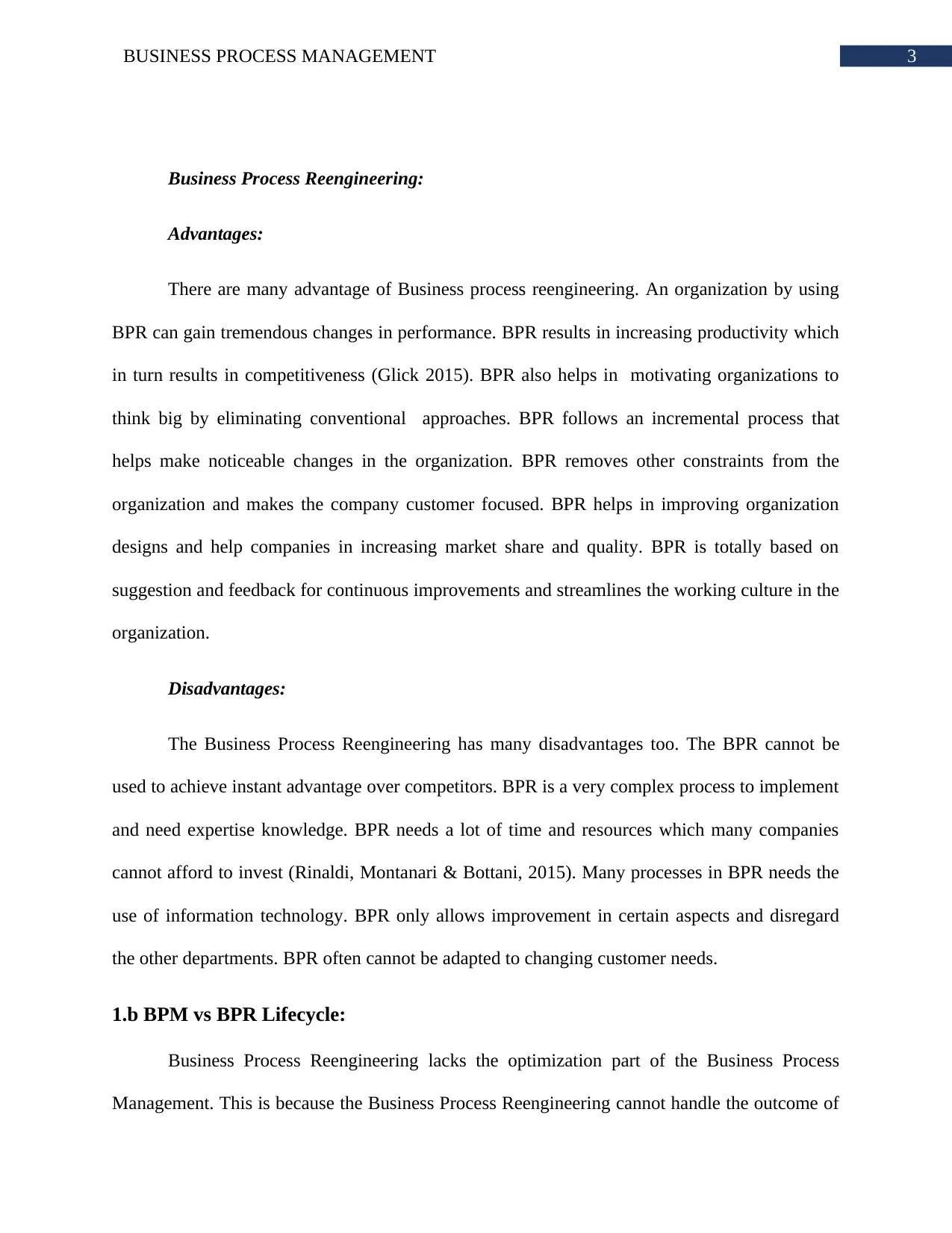
3BUSINESS PROCESS MANAGEMENT
Business Process Reengineering:
Advantages:
There are many advantage of Business process reengineering. An organization by using
BPR can gain tremendous changes in performance. BPR results in increasing productivity which
in turn results in competitiveness (Glick 2015). BPR also helps in motivating organizations to
think big by eliminating conventional approaches. BPR follows an incremental process that
helps make noticeable changes in the organization. BPR removes other constraints from the
organization and makes the company customer focused. BPR helps in improving organization
designs and help companies in increasing market share and quality. BPR is totally based on
suggestion and feedback for continuous improvements and streamlines the working culture in the
organization.
Disadvantages:
The Business Process Reengineering has many disadvantages too. The BPR cannot be
used to achieve instant advantage over competitors. BPR is a very complex process to implement
and need expertise knowledge. BPR needs a lot of time and resources which many companies
cannot afford to invest (Rinaldi, Montanari & Bottani, 2015). Many processes in BPR needs the
use of information technology. BPR only allows improvement in certain aspects and disregard
the other departments. BPR often cannot be adapted to changing customer needs.
1.b BPM vs BPR Lifecycle:
Business Process Reengineering lacks the optimization part of the Business Process
Management. This is because the Business Process Reengineering cannot handle the outcome of
Business Process Reengineering:
Advantages:
There are many advantage of Business process reengineering. An organization by using
BPR can gain tremendous changes in performance. BPR results in increasing productivity which
in turn results in competitiveness (Glick 2015). BPR also helps in motivating organizations to
think big by eliminating conventional approaches. BPR follows an incremental process that
helps make noticeable changes in the organization. BPR removes other constraints from the
organization and makes the company customer focused. BPR helps in improving organization
designs and help companies in increasing market share and quality. BPR is totally based on
suggestion and feedback for continuous improvements and streamlines the working culture in the
organization.
Disadvantages:
The Business Process Reengineering has many disadvantages too. The BPR cannot be
used to achieve instant advantage over competitors. BPR is a very complex process to implement
and need expertise knowledge. BPR needs a lot of time and resources which many companies
cannot afford to invest (Rinaldi, Montanari & Bottani, 2015). Many processes in BPR needs the
use of information technology. BPR only allows improvement in certain aspects and disregard
the other departments. BPR often cannot be adapted to changing customer needs.
1.b BPM vs BPR Lifecycle:
Business Process Reengineering lacks the optimization part of the Business Process
Management. This is because the Business Process Reengineering cannot handle the outcome of
Paraphrase This Document
Need a fresh take? Get an instant paraphrase of this document with our AI Paraphraser

4BUSINESS PROCESS MANAGEMENT
the optimizations like the Business Process Management. In this respect, Business Process
Management is advantageous as it supports optimization.
1.c Combining BPM and BPR:
The ability to quickly change a process is a feature of business process management. In
business process reengineering, the whole process needs to be developed from the scratch. The
combination of business process management and business process reengineering is only
possible in a continuous process. A continuous process is the only type of process that supports
both incremental and new process development.
2. Foundations of BPMN:
Questions Answer
How would you connect 2 BPMN pools with each other
and how would you connect elements within one of these
pools?
Message flows and sequence
flows
Which connection elements in the following BPD are
associations
The connection element going
into and out of the open as well
as the approved vacation request
Assume for the following BPD that all start events are
triggered at once (i.e. they all get a token). How many
times will D be executed before the process ends?
0 times, the process model is
wrong
Which BPMN element would normally be used to
represent entities from a hierarchical organizational chart?
The Pool and Lane elements
What kind of BPMN construct is used to reverse, restore or Transaction
the optimizations like the Business Process Management. In this respect, Business Process
Management is advantageous as it supports optimization.
1.c Combining BPM and BPR:
The ability to quickly change a process is a feature of business process management. In
business process reengineering, the whole process needs to be developed from the scratch. The
combination of business process management and business process reengineering is only
possible in a continuous process. A continuous process is the only type of process that supports
both incremental and new process development.
2. Foundations of BPMN:
Questions Answer
How would you connect 2 BPMN pools with each other
and how would you connect elements within one of these
pools?
Message flows and sequence
flows
Which connection elements in the following BPD are
associations
The connection element going
into and out of the open as well
as the approved vacation request
Assume for the following BPD that all start events are
triggered at once (i.e. they all get a token). How many
times will D be executed before the process ends?
0 times, the process model is
wrong
Which BPMN element would normally be used to
represent entities from a hierarchical organizational chart?
The Pool and Lane elements
What kind of BPMN construct is used to reverse, restore or Transaction
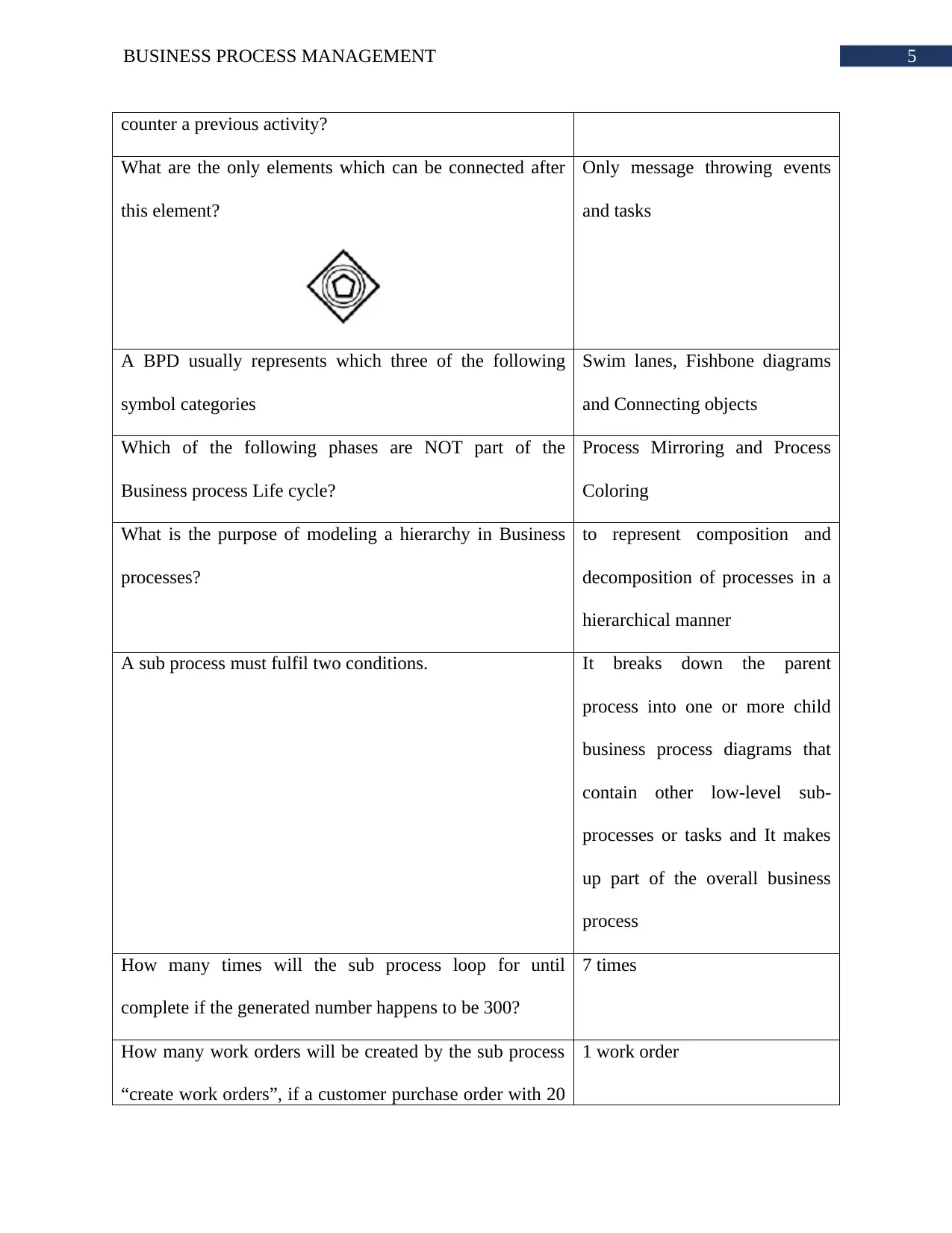
5BUSINESS PROCESS MANAGEMENT
counter a previous activity?
What are the only elements which can be connected after
this element?
Only message throwing events
and tasks
A BPD usually represents which three of the following
symbol categories
Swim lanes, Fishbone diagrams
and Connecting objects
Which of the following phases are NOT part of the
Business process Life cycle?
Process Mirroring and Process
Coloring
What is the purpose of modeling a hierarchy in Business
processes?
to represent composition and
decomposition of processes in a
hierarchical manner
A sub process must fulfil two conditions. It breaks down the parent
process into one or more child
business process diagrams that
contain other low-level sub-
processes or tasks and It makes
up part of the overall business
process
How many times will the sub process loop for until
complete if the generated number happens to be 300?
7 times
How many work orders will be created by the sub process
“create work orders”, if a customer purchase order with 20
1 work order
counter a previous activity?
What are the only elements which can be connected after
this element?
Only message throwing events
and tasks
A BPD usually represents which three of the following
symbol categories
Swim lanes, Fishbone diagrams
and Connecting objects
Which of the following phases are NOT part of the
Business process Life cycle?
Process Mirroring and Process
Coloring
What is the purpose of modeling a hierarchy in Business
processes?
to represent composition and
decomposition of processes in a
hierarchical manner
A sub process must fulfil two conditions. It breaks down the parent
process into one or more child
business process diagrams that
contain other low-level sub-
processes or tasks and It makes
up part of the overall business
process
How many times will the sub process loop for until
complete if the generated number happens to be 300?
7 times
How many work orders will be created by the sub process
“create work orders”, if a customer purchase order with 20
1 work order
⊘ This is a preview!⊘
Do you want full access?
Subscribe today to unlock all pages.

Trusted by 1+ million students worldwide

6BUSINESS PROCESS MANAGEMENT
items listed is received?
If a process token reaches a terminate end event, it… stops the entire process at the
same level as well as all sub
processes
If the non-interrupting timer boundary event attached to the
activity “review admissions” is triggered, it means that
stop reviewing admissions and
perform the activity downstream
from the timer
event
3. Intermediate BPMN:
3.1 Explaining BPMN Model:
The process described checking of complaint. The complaint is checked periodically until
5 pm. The entire process ends at 5 pm. The sub process ends when staff cannot find a new
process or 2 hours or complaint is processed. Customer support department include this process.
3.2 BPMN Model Review:
I
D
Mistake BPMN Specification
1 Instead of catching the event, the
Application Returned to Applicant is
throwing the intermediate event
The message intermediate event must be
thrown by an event that is indicating
information flow to the external pool.
2 The outflow of the sequence x-or
gateway is not correct.
Yes or No should be the only answers for
sequence X-or gateway.
3 There is no label on the X-or gateway. Using the conventional way, an X-or gateway
items listed is received?
If a process token reaches a terminate end event, it… stops the entire process at the
same level as well as all sub
processes
If the non-interrupting timer boundary event attached to the
activity “review admissions” is triggered, it means that
stop reviewing admissions and
perform the activity downstream
from the timer
event
3. Intermediate BPMN:
3.1 Explaining BPMN Model:
The process described checking of complaint. The complaint is checked periodically until
5 pm. The entire process ends at 5 pm. The sub process ends when staff cannot find a new
process or 2 hours or complaint is processed. Customer support department include this process.
3.2 BPMN Model Review:
I
D
Mistake BPMN Specification
1 Instead of catching the event, the
Application Returned to Applicant is
throwing the intermediate event
The message intermediate event must be
thrown by an event that is indicating
information flow to the external pool.
2 The outflow of the sequence x-or
gateway is not correct.
Yes or No should be the only answers for
sequence X-or gateway.
3 There is no label on the X-or gateway. Using the conventional way, an X-or gateway
Paraphrase This Document
Need a fresh take? Get an instant paraphrase of this document with our AI Paraphraser

7BUSINESS PROCESS MANAGEMENT
must have a label for clarity.
4 The tool for evaluating Credit History
processes and joining Check housing
availability is done by parallel gateway
For both the processes mentioned X-and
gateway should be used.
5 Inclusive Gateway outflow sequence is
lacking proper labels
The possible conditions can be used as labels
for each sequence flow of messages
6 The labelling of lane is not done There should be a label for each lane and pool
7 The labelling of X-or gateway is not
done
Labelling of X-or gateway should be done for
better understanding following the
conventional way.
8 The Sequence outflow of x-or gateway
is labelled as not eligible condition.
Yes or No should be sequence outflow of x-or
gateway
9 The sequence flow of reject application
process is toward the external pool
Communication with External pools can be
done using message events
10 The labelling of data object is not done It is mandatory to label every element
11 Intermediate message event named
Updated Application Received does not
have message inflow from a process
A message outflow cannot be done from a pool
directly
12 Start event and end event are not same If message start event is used then message
end event must be used
13 Improper use of gateway in insurance
evaluation
The gateways used in that lane does not
describe the scenario properly
14 Reject application denote end of process End denoting processes should be connected to
must have a label for clarity.
4 The tool for evaluating Credit History
processes and joining Check housing
availability is done by parallel gateway
For both the processes mentioned X-and
gateway should be used.
5 Inclusive Gateway outflow sequence is
lacking proper labels
The possible conditions can be used as labels
for each sequence flow of messages
6 The labelling of lane is not done There should be a label for each lane and pool
7 The labelling of X-or gateway is not
done
Labelling of X-or gateway should be done for
better understanding following the
conventional way.
8 The Sequence outflow of x-or gateway
is labelled as not eligible condition.
Yes or No should be sequence outflow of x-or
gateway
9 The sequence flow of reject application
process is toward the external pool
Communication with External pools can be
done using message events
10 The labelling of data object is not done It is mandatory to label every element
11 Intermediate message event named
Updated Application Received does not
have message inflow from a process
A message outflow cannot be done from a pool
directly
12 Start event and end event are not same If message start event is used then message
end event must be used
13 Improper use of gateway in insurance
evaluation
The gateways used in that lane does not
describe the scenario properly
14 Reject application denote end of process End denoting processes should be connected to

8BUSINESS PROCESS MANAGEMENT
but is not connected to any end event an end event
15 Prepare Student Housing Form has
message inflow from data object
Data object does not support message outflow
or inflow
Corrected Diagram:
but is not connected to any end event an end event
15 Prepare Student Housing Form has
message inflow from data object
Data object does not support message outflow
or inflow
Corrected Diagram:
⊘ This is a preview!⊘
Do you want full access?
Subscribe today to unlock all pages.

Trusted by 1+ million students worldwide
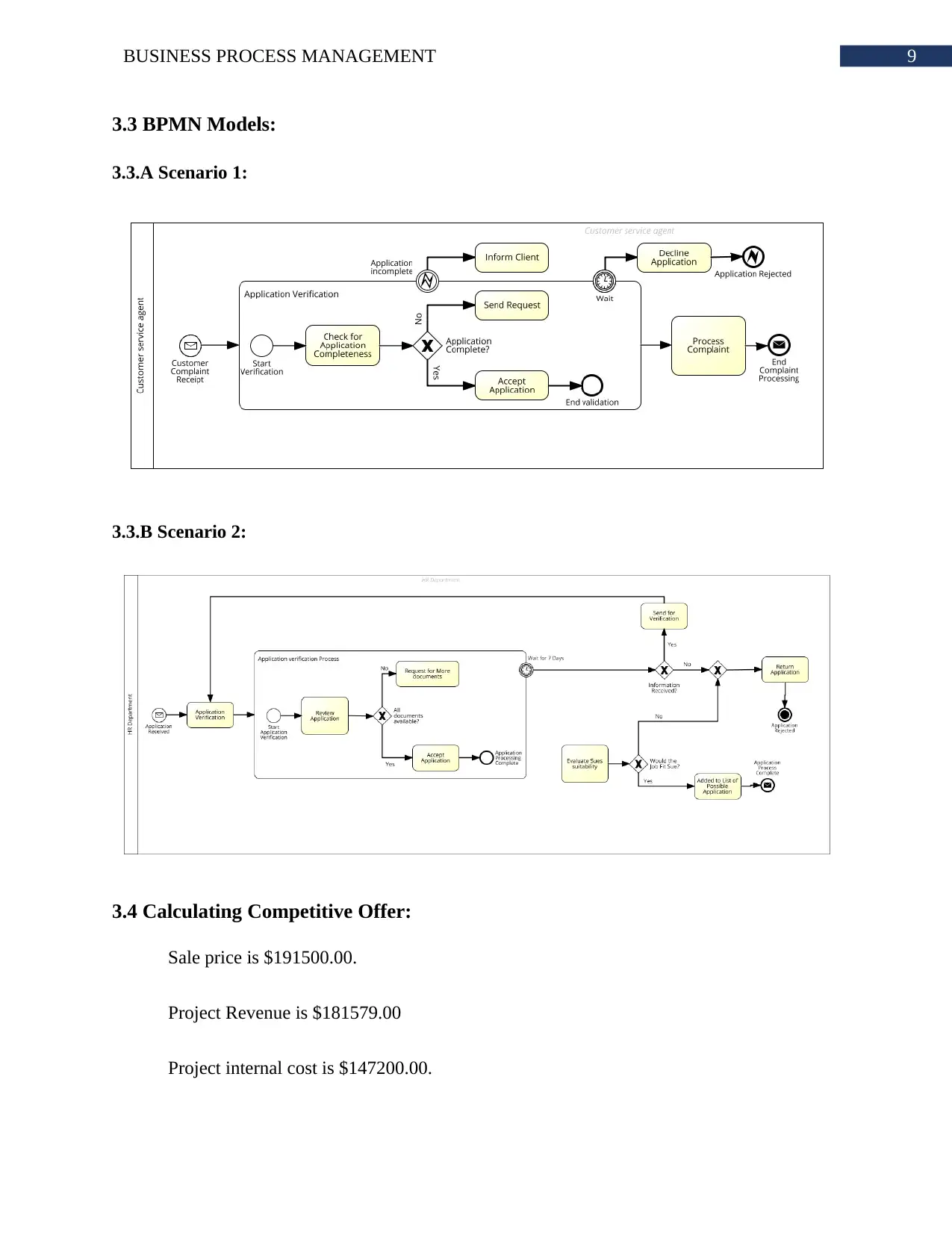
9BUSINESS PROCESS MANAGEMENT
3.3 BPMN Models:
3.3.A Scenario 1:
3.3.B Scenario 2:
3.4 Calculating Competitive Offer:
Sale price is $191500.00.
Project Revenue is $181579.00
Project internal cost is $147200.00.
3.3 BPMN Models:
3.3.A Scenario 1:
3.3.B Scenario 2:
3.4 Calculating Competitive Offer:
Sale price is $191500.00.
Project Revenue is $181579.00
Project internal cost is $147200.00.
Paraphrase This Document
Need a fresh take? Get an instant paraphrase of this document with our AI Paraphraser

10BUSINESS PROCESS MANAGEMENT
Profit from the project is $34,379.00.
Duration of the project is 92 days.
The project team size is four workers and four materials. Working People are Managing
Analyst, Managing Analyst, Lead Analysts, Consultant Analysts, Young Analysts, Consulting
MA, Consulting LA, Consulting CA and Consulting YA.
Profit from the project is $34,379.00.
Duration of the project is 92 days.
The project team size is four workers and four materials. Working People are Managing
Analyst, Managing Analyst, Lead Analysts, Consultant Analysts, Young Analysts, Consulting
MA, Consulting LA, Consulting CA and Consulting YA.

11BUSINESS PROCESS MANAGEMENT
⊘ This is a preview!⊘
Do you want full access?
Subscribe today to unlock all pages.

Trusted by 1+ million students worldwide
1 out of 13
Related Documents
Your All-in-One AI-Powered Toolkit for Academic Success.
+13062052269
info@desklib.com
Available 24*7 on WhatsApp / Email
![[object Object]](/_next/static/media/star-bottom.7253800d.svg)
Unlock your academic potential
Copyright © 2020–2025 A2Z Services. All Rights Reserved. Developed and managed by ZUCOL.




